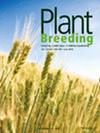与高粱(Sorghum bicolor (L. Moench))A4(maldandi)雄性不育细胞质生育力恢复新性状相关的 SSR 标记的鉴定
IF 1.8
4区 农林科学
Q2 AGRONOMY
引用次数: 0
摘要
鉴定与生育力恢复(Rf)基因相关的标记至关重要,因为它们可以简化 CMS 新品系的育种和商业杂交种子的生产。因此,在本研究中,利用 F2 群体(M31-2A × DSMR 8),通过大量分离分析(BSA)来鉴定与马兰头(A4)细胞质上 Rf 基因座相关的标记。对 F2 群体进行了结实率分析。Chi-square(χ2)分析表明,生育力恢复性状遵循预期的二基因比率。通过 BSA,简单序列重复(SSR)标记,即位于 3 号染色体上的 Xtxp 34 和 Xtxp 69 以及位于 7 号染色体上的 SB 3956 和 Xtxp 312,在两组可育和不育群体之间显示出明显的多态性。3 号染色体上 Rf 基因座所在的基因组区域(2.61 Mbp)预测编码五个五肽重复(PPR)基因,而 7 号染色体上的基因 SORBI_3007G047400 预测编码含 MYB(骨髓母细胞病)结构域的蛋白质。这些预测基因可能是恢复 A4 细胞质生育能力的候选基因。这一发现将为生产和快速筛选新型恢复系奠定基础。本文章由计算机程序翻译,如有差异,请以英文原文为准。
Identification of SSR markers linked to new fertility restoration trait in sorghum (Sorghum bicolor (L.) Moench) for A4 (maldandi) male sterile cytoplasm
Identification of markers associated with fertility restoration (Rf) genes is essential because they can streamline the breeding of new CMS lines and production of commercial hybrid seeds. Therefore, in the present study, F2 populations (M31-2A × DSMR 8) was utilized to identify markers linked to Rf loci on maldandi (A4) cytoplasm through bulk segregant analysis (BSA). The F2 population was analysed for seed set percentage. Chi-square (χ2) analysis showed that the fertility restoration trait followed expected digenic ratio. By BSA, simple sequence repeats (SSRs) markers, namely, Xtxp 34 and Xtxp 69 located on chromosome 3 and SB 3956 and Xtxp 312 located on chromosome 7, showed clear polymorphism between two groups of fertile and sterile bulks. The genomic region harbouring Rf locus on chromosome 3 (2.61 Mbp) predicted to encode five pentatricopeptide repeat (PPR) genes whereas, on chromosome 7, the gene SORBI_3007G047400 predicted to encode MYB (myeloblastosis) domain containing proteins. These predicted genes could be the candidate for restoring fertility on A4 cytoplasm. This finding will be fundamental in the production and rapid selection of novel restorer lines.
求助全文
通过发布文献求助,成功后即可免费获取论文全文。
去求助
来源期刊

Plant Breeding
农林科学-农艺学
CiteScore
4.40
自引率
5.00%
发文量
74
审稿时长
3.0 months
期刊介绍:
PLANT BREEDING publishes full-length original manuscripts and review articles on all aspects of plant improvement, breeding methodologies, and genetics to include qualitative and quantitative inheritance and genomics of major crop species. PLANT BREEDING provides readers with cutting-edge information on use of molecular techniques and genomics as they relate to improving gain from selection. Since its subject matter embraces all aspects of crop improvement, its content is sought after by both industry and academia. Fields of interest: Genetics of cultivated plants as well as research in practical plant breeding.
 求助内容:
求助内容: 应助结果提醒方式:
应助结果提醒方式:


